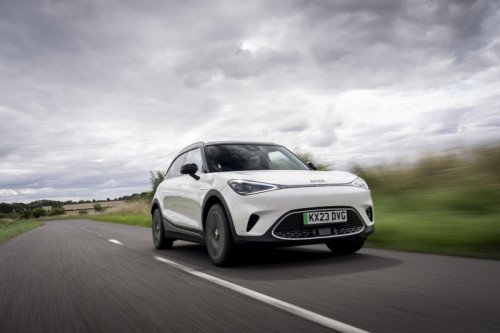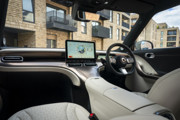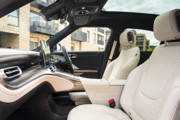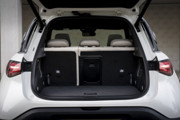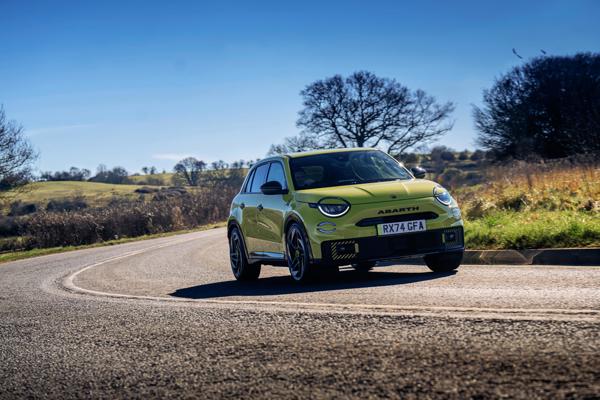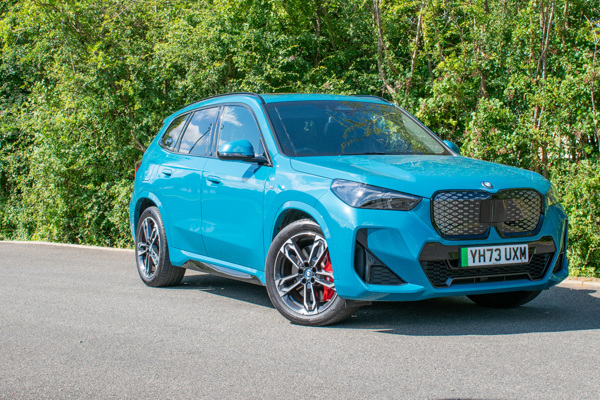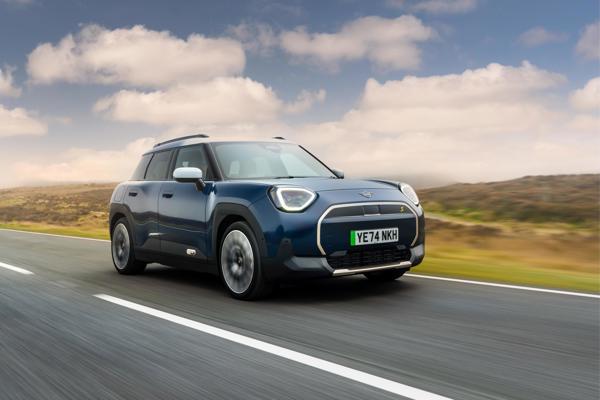Review
Smart’s re-birth has been a significant one. The #1 is a monumental step forward for the brand and a car that suits the needs of the fleet market, as it moves to electric propulsion. It’s stylish, well-equipped and good to drive. Competitive pricing places it keenly against rivals and, while the boot is a little small and there’s a few irritations with the technology, the overall package is highly desirable.
Overview
The Smart #1 (pronounced hashtag one) is the first model to be developed since the Smart brand became jointly owned by Geely and Mercedes-Benz.
It’s a fully electric compact crossover that competes alongside the Hyundai Kona Electric, Renault Megane E-Tech and VW ID3.
Development of the new car was a joint effort. Mercedes did most of the design work, inside and out, while the platform and chassis come from Geely and are shared with the Volvo EX30.
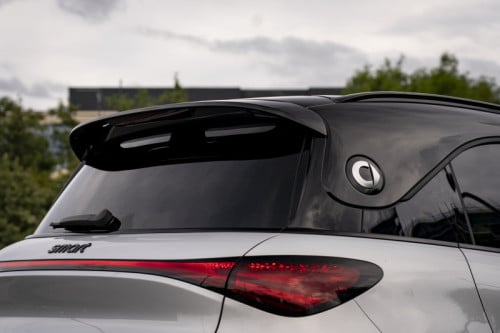
The exterior styling bears a close resemblance to the current Mercedes EQ line-up, with the brand’s signature front and rear LED light bars incorporated into the design. The Smart has been given a more daring look, with a floating roof and curvier proportions, than a Mercedes model.
Prices for the Smart #1 start at £35,950, for the Pro+ version, rising to £38,950 for the Premium. Both use the same powertrain. A sportier, twin-motor, Brabus version is also available for £43,450.
Comfort and practicality
Unlike previous Smart models, the #1 is geared closer to the premium end of the market and, as such, has been given a more upmarket interior and improved ride and refinement.
Despite its footprint being close to that of a Nissan Juke, Smart claims that the #1 offers a comparable interior space to a Mercedes E-Class. Once inside, it’s clear the #1 is a roomy car. The rear seat space is particularly generous and there’s decent headroom for all occupants.
Boot space is less impressive, with just 273 litres on offer. You can sacrifice rear legroom for more luggage capacity by sliding the rear seat bench forward. This provides up to 411 litres of space.
There’s a useful storage compartment under the boot floor, which can be used to stow the charging cables, and a 15-litre ‘froot’ under the bonnet.
The driving position is relatively high, but when combined with the raised centre console that flows from the dashboard, it encapsulates the driver and helps to give a sportier feel to the car.
A standard-fit sunroof helps to flood the interior with light and enhances the feeling of spaciousness.
Safety and technology
It’s hard to miss the Smart #1’s 12.8-inch central touchscreen as it dominates the car’s interior. The high-resolution display is connected to a powerful computer that delivers a high-tech and impressive user experience.
The system is configured to work in conjunction with Smart’s smartphone app, which enables remote interaction with the vehicle and can be used as a digital key. You can also tailor the car’s setting to each individual user.
A row of touch-sensitive buttons provide speedy access to key functions for the climate control and drive modes. The audio volume can only be adjusted via the buttons on the steering wheel or via the touchscreen, however.
Many of the car’s functions can be handled by the voice-controlled personal assistant, which takes the form of a cartoon animated fox that lives in the infotainment screen and paces around from time-to-time. It’s a bit like that paperclip from a popular word processing package in the 90s.

All Smart #1s come with a suite of driver assistance and safety systems as standard, including adaptive cruise control, blind spot monitoring and lane keep assist. The setup also includes a driver alertness monitor, which we found particularly frustrating as it would repeatedly ping up a “DRIVER DISTRACTED” warning message every time you look at the sat-nav screen or out the window. It appeared to be the only safety system that could not be disabled via the car’s settings menu.
Driveability and range
The Smart #1 Pro+ and Premium use a 272PS electric motor that sends power to the rear wheels, giving punchy performance and a 0-62mph acceleration time of 6.7 seconds.
The Brabus version has a second electric motor that powers the front wheels. This pushes the power output to 428PS, giving a 0-62mph sprint time of just 3.9 seconds.
All models feature a 62kWh (useable) battery. It provides a range of 260 miles in the Pro+, 272 miles in the Premium and 248 in the Brabus.
The single motor cars feel suitably potent, giving punchy acceleration when needed. The Brabus model is fiercely rapid when you step on the throttle, especially if you select the Brabus driving mode, which also firms up the steering.

In either guise, the Smart #1 is enjoyable to drive without feeling overtly sporty. There is firmness to the ride that can become harsh over potholes and rough roads, but in most situations the #1 is comfortable.
The steering is light and direct in feel, which provides a nimble feel to the handling. At higher speeds and on the motorway the car remains stable and relaxing to drive.
During our test, the single motor powertrain was easily achieving 4.0mi/kWh, suggesting a real-world range of 240 miles would be achievable.
Company car tax and running costs
As a fully electric car, the Smart #1 attracts a 2% benefit-in-kind tax charge for the 2023/24 tax year. A 20% taxpayer should expect to pay £12 per month for the Pro+, £13 for the Premium and £14 for the Brabus.
Smart has bundled a high level of equipment in as standard, so even the entry-level model has a 360-degree camera system, heated front seats, LED headlights and an electric tailgate.
The Premium adds a head-up display, Beats sound system and matrix LED lights. It also comes with a heat pump and a modified inverter, which provides a longer range.
There are no options to be added, only a choice of colour, and Smart is adopting a transparent fixed pricing policy to simplify transactions. A three-year servicing package is also included within the price.
Charging speeds
3-pin plug: 29hrs
7kW wallbox: 10hrs
22kW AC: 3hrs (Premium and Brabus only)
150kW rapid: 30mins (10%-80%)
Specs
| Manufacturer | Smart |
| Model | Hashtag 1 Hatchback |
| Specification | Smart Hashtag 1 Hatchback 200kW Pro + 66kWh 5dr Auto |
| Model Year | 2023.00 |
| Annual VED (Road tax) | £10 |
| BIK List Price | £36,895 |
| Range | 261.00mile(s) |
| CO2 | N/A |
| BIK Percentage | 2% |
| Insurance Group | N/A |
| CC | 1 |
| Fuel Type | Electric |
| Vehicle Type | Compact SUV |
| Luggage capacity (Seats up) | 323litres |
| Doors | 5 |
Running Costs
| P11D | £36,895 |
| Cost per mile | 45.28ppm |
| Residual value | £14,450 |
| Insurance group | N/A |
| Fuel Type | Electric |
| Cost per mile | 159.51ppm |
| Fuel | 2.52ppm |
| Depreciation | 154.50ppm |
| Service maintenance and repair | 2.49ppm |
Rivals
Info at a glance
-
P11D Price
£36,895
-
MPG
N/A (WLTP) -
CO2 Emissions
N/A -
BIK %
2% -
Running cost
3 Year 60k : £14,450 4 Year 80k : £11,875 -
Fuel Type
Electric -
Range
261.00mile(s)



